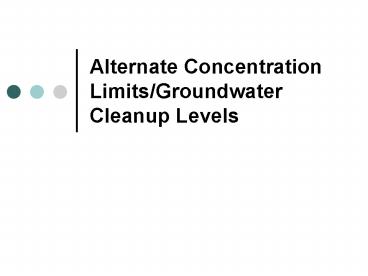Alternate Concentration LimitsGroundwater Cleanup Levels - PowerPoint PPT Presentation
1 / 25
Title:
Alternate Concentration LimitsGroundwater Cleanup Levels
Description:
Alternate Concentration Limits (ACL) Terms and Definitions. 40 CFR 264 Subpart F Definitions ... Facility specific chemical concentrations in ground water that ... – PowerPoint PPT presentation
Number of Views:138
Avg rating:3.0/5.0
Title: Alternate Concentration LimitsGroundwater Cleanup Levels
1
Alternate Concentration Limits/Groundwater
Cleanup Levels
2
Alternate Concentration Limits (ACL)Terms and
Definitions
- 40 CFR 264 Subpart F Definitions
- Regulated Unit
- Ground Water Protection Standard (GWPS)
- Point of Compliance (POC)
- Point of Exposure (POE)
- Facility Boundary
3
ACL Terms and Definitions
4
GWPS Concentration Limits
- Background Concentrations of Constituents
- 40 CFR 264.94(a)(1)
- Table 1 Constituents
- 40 CFR 264.94(a)(2)
- Alternate Concentration Limits (ACLs)
- 40 CFR 264.94(a)(3)
- 40 CFR 264.94(b)
5
How Are ACLs Determined?
- Incorporates the concept of attenuation
- An acceptable human-health or ecological risk
value is determined for the POE. The ACL is then
calculated for the POC taking into account an
attenuation factor derived from the physical and
chemical conditions at the facility between the
POC and POE
6
EPA Policy Regarding the Use of ACLs
- Ground water plumes should not increase in size
or concentration above allowable health or
environmental exposure levels - Increased facility property holdings should not
be used to allow a greater ACL - ACLS should not be established so as to
contaminate off-site ground water above allowable
health or environmental exposure levels
7
Case 1
8
Case 2
9
Case 3
10
Case 4
11
Case 5
12
ACL Evaluation Criteria
- Groundwater Criteria
- Physical and chemical characteristics of the
waste - Hydrogeological characteristics of the facility
- Quantity of ground-water flow and direction of
ground-water flow - Proximity and withdrawal rates of ground-water
users - Current and future uses of ground water
13
ACL Evaluation Criteria
- Groundwater Criteria (continued)
- Existing quality of ground water
- Potential for health risks caused by human
exposure to waste constituents - Potential damage to wildlife, crops, vegetation,
and physical structures - Persistence and permanence of the potential
adverse effects
14
ACL Evaluation Criteria
- Surface Water Criteria
- Physical and chemical characteristics of the
waste - Hydrogeological characteristics of the facility
- Quantity and quality of ground-water flow and
direction of ground-water flow - Patterns of rainfall in the region
- Proximity to surface waters
15
ACL Evaluation Criteria
- Surface Water Criteria (continued)
- Current and future uses of surface water
- Existing quality of surface water
- Potential for health risks caused by human
exposure to waste constituents - Potential damage to wildlife, crops, vegetation,
and physical structures - Persistence and permanence of the potential
adverse effects
16
Appropriate Usage of ACLs/ Regulatory Basis
- RCRA Permit Usage
- ACLS were developed to serve as GWPSs for
regulated units under 40 CFR 264.94(b). As a
result, they directly apply for usage in RCRA
permitting cases
17
Appropriate Usage of ACLs/ Regulatory Basis
- RCRA Corrective Action Usage
- ACLs do not apply to facility-wide corrective
action (CA) of solid waste management units
(SWMUs) under 40 CFR 264.101. However, many of
the ACL concepts and approaches can be used in
developing cleanup levels for site-wide CA
18
Appropriate Usage of ACLs/ Regulatory Basis
- Superfund (CERCLA) Usage
- Per CERCLA Section 121(d)(2)(B)(ii), ACLs may be
established as ARARs under 3 conditions - Contaminated ground water discharges to surface
water - The discharge of contaminated ground water to
surface water does not result in statistically
significant increases of contaminants in the
surface water - Enforceable measures can be implemented to
prevent human consumption of the contaminated
ground water
19
Appropriate Usage of ACLs/ Regulatory Basis
- Superfund (CERCLA) Usage (continued)
- ACLs may be useful under the above conditions for
addressing ground water contamination where it is
impracticable or impossible to achieve the
existing GWPS based on the Superfund remedy
selection balancing criteria, and the ACLs can be
shown to be protective of human health and the
environment
20
Ground Water Cleanup Levels (GWCLs) Terms and
Definitions
- Facility specific chemical concentrations in
ground water that define the ground water cleanup
objectives for final remedies. They provide
clear numerical targets that stakeholders can use
to measure the success of ground water cleanup
actions - Based on the maximum beneficial use to ensure
that ground water is cleaned up to levels that
protect human health and the environment, both
now and in the future
21
Derivation of GWCLs
- Use existing cleanup standards (e.g. drinking
water standards - MCLs) when available - If existing standards are not available, develop
risk-based cleanup levels - For carcinogens 10-4 to 10-6 risk range
- For non-carcinogens Hazard Quotient or Hazard
Index less than or equal to 1
22
Lack of Necessity for GWCLs
- GWCLs may not be necessary under certain
circumstances - Contaminated ground water is within a
non-drinking water aquifer - Ground water has no current or foreseeable
beneficial use - Does not discharge to surface water or a drinking
water aquifer at levels of concern - Does not cause exposure through cross-media
transfer - However, ground water monitoring may still be
required to ensure these conditions do not change
over time
23
Methods for Developing ACLs/ GWCLs
- Manual calculation methods - use of various
equations (e.g. ASTM Soil Leaching, SAM,
Domenico) to manually derive cross-media transfer
and attenuation factors, and resulting ACLs/GWCLs - Commercial Software e.g. ASTM RCBA Tool Kit
24
Pitfalls in Developing ACLs/GWCLs and Other
Concerns
- Lack of appropriate documentation
- Inappropriate site-specific parameters (e.g.,
hydraulic conductivity, porosity, fraction
organic carbon, dispersivity, contaminant
half-lives) - Different risk-based criteria
- Use of software not approved/endorsed by the
Region or State
25
Pitfalls in Developing ACLs/GWCLs and Other
Concerns (continued)
- Biological breakdown products and synergistic
effects - Exposure pathways
- Others?































